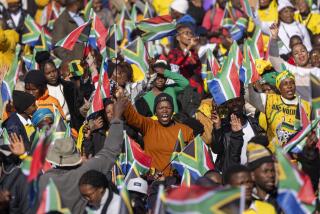South Africaâs Top Killer Occupies the Driverâs Seat : Traffic: Nearly three times as many people died in road accidents last year as perished in rampant political violence.
JOHANNESBURG, South Africa â In a land with one of the worldâs worst murder rates and a horrific history of political bloodletting, the deadliest killer by far is much more mundane: traffic.
As Americans count the traditional death toll of the Memorial Day weekend, in South Africa, the deaths of 50 people in a bus accident and a minibus collision with a car and truck last Thursday underscored this nationâs grim status as one of the worldâs most dangerous places to drive. Or for that matter, even to walk.
More than 10,000 people died in traffic accidents here last year, or almost three times the number of people killed in political violence. Almost half the victims were pedestrians, mostly hit near the black townships and squatter camps that line many highways.
The chief cause of the carnage is simple, said Quinton van Eeden, assistant general manager of the Automobile Assn. of South Africa. âUnfortunately, the biggest problem is the driver,â he said. âSouth Africans, Iâd say in general, tend to be quite aggressive. We also have severe literacy problems. That sort of thing needs to change.â
Apartheid may be dead, but its lethal legacy survives on South Africaâs roads. The collision of First and Third World cars and conditions produces a daily litany of what newspapers inevitably call âhorror crashes.â
There are enough rich whites to support a BMW factory here, and their Mercedes-Benzes and other high-powered cars zoom at 75 m.p.h. along modern highways. Most blacks, however, commute in overcrowded minibuses used as taxis, while migrant workers and families heading home huddle in the back of slow-moving trucks.
âThe problem here is youâve got fast cars and slow cars,â said Hubrecht Ribbins, head of traffic safety technology at CSIR, a private Pretoria-based research group. âThe differentiation is a real problem, especially at night. When you have a truck filled with people going slowly home, and then a BMW comes along at high speed and doesnât expect anything, you get a rear-end collision.â
Then thereâs corruption. To avoid South Africaâs strict licensing tests, Ribbins estimates up to 1 million drivers--about 20% of the total--use bogus licenses obtained from now-abolished homeland governments or bought on a thriving black market.
But a chief cause of the staggering body count is minibus taxis. They can carry 16 passengers but often cram in dozens more. They barrel along at high speed, suddenly stopping to pick up or offload passengers. Drivers go hours without rest, afraid of stopping to sleep on roads plagued by bandits.
Few South Africans wear seat belts. And drunk drivers are a major problem. But Robin Scholtz, an Automobile Assn. spokesman, insists alcohol plays another role as well. âOur biggest problem is drunken pedestrians,â he said. âThey wander across the road, and the poor motorist hits them.â
It doesnât help that sidewalks and pavements donât exist in most towns and townships. So poor people without transportation must walk in the road. And despite the dangers, few pedestrians wear light or reflective clothing at night. Only 1 in 100 blacks owns a car, while about half the whites do.
According to the Automobile Assn., South Africaâs traffic fatality rate--about 35 per 100,000 people--ranks worst among 20 countries that it follows. Itâs twice Americaâs rate, and higher than Third World nations such as Brazil, Botswana and Kenya. South Korea has the second-worst fatality rate with 27.
Still, South Korea doesnât have hippos. In a 1991 accident here, three cars and a 30-ton truck were nearly demolished in the Transvaal when they slammed into a hippopotamus and one another. Two people were injured; the hippo died.
More to Read
Sign up for Essential California
The most important California stories and recommendations in your inbox every morning.
You may occasionally receive promotional content from the Los Angeles Times.











